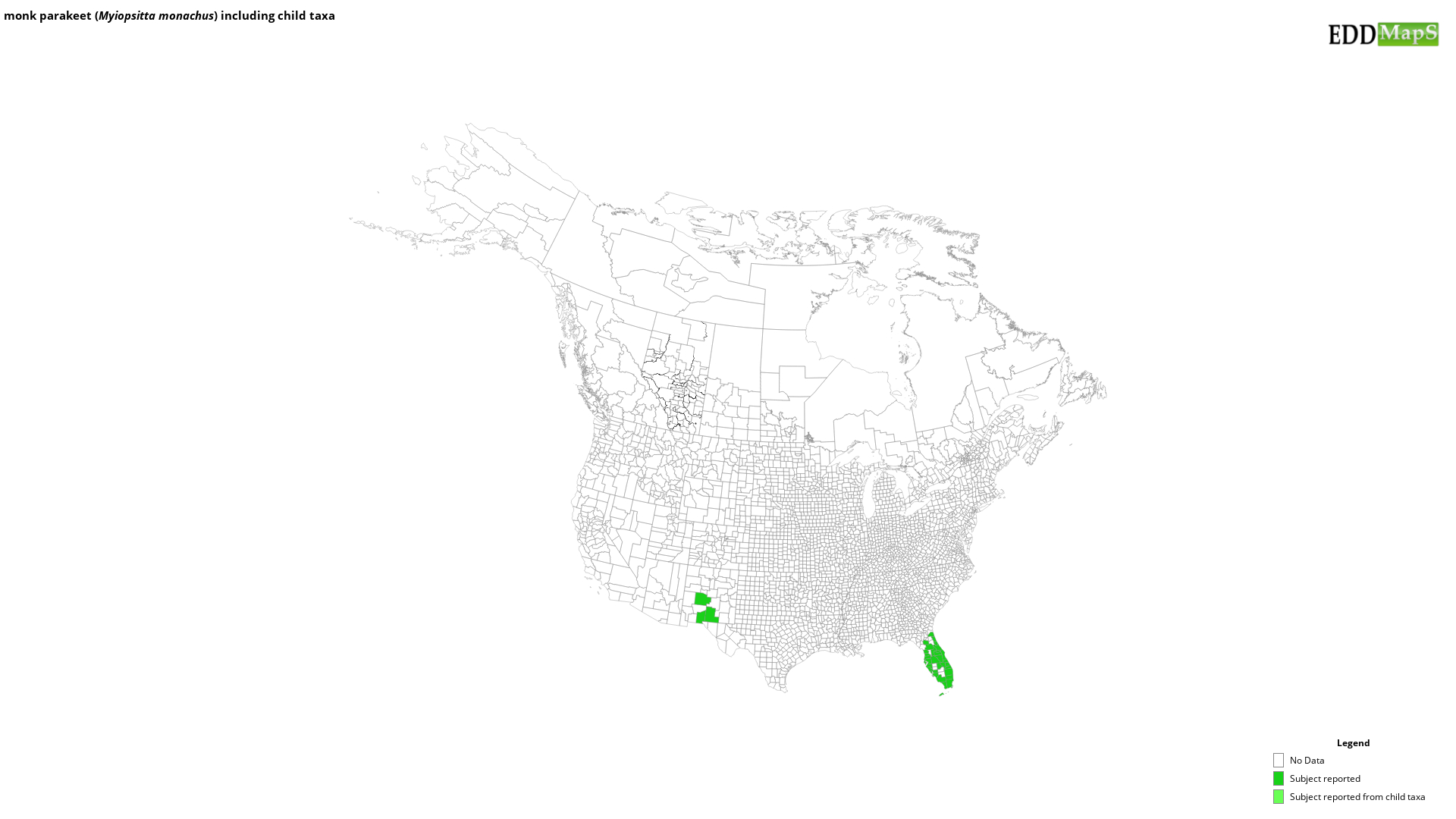monk parakeet
(Myiopsitta monachus)
This species is Introduced in the United States
Origin
Myiopsitta monachus is native to South America. Monk parrots were introduced to the United States in the 1960s as intentionally released or escaped pets.
Life Cycle
Adult parrots are slightly smaller than other parakeets at 11.5 in. (29 cm) in length and a wingspan of 18.8 in. (48 cm). M. monachus are green in plumage with a gray face and breast as well as blue primary and outer secondary flight feathers. Sexes are not identifiably different in appearance. M. monachus are the only member of the parrot family to build nests out of sticks and to live in colonies. In its non-native range, Monk parrots live in urban and suburban landscapes with nests on structures such as utility poles. Nest structures are very large and can weigh more than a ton. Each nest structure can contain up to 20 different nesting chambers where females lay 5-8 eggs per clutch.
Distribution
Monk parrot populations occur in several states including California, Arizona, Texas, Louisiana, Illinois, New York, Florida, and Rhode Island. M. monachus can tolerate temperate climates which has allowed it to become established all over the United States.
Control Efforts
One form of control includes removing nest sites on man-made structures and providing alternative nesting sites in cities. There is debate on the appropriate form of management due to experts disagreeing on whether monk parrots are a nuisance in cities and agriculture.
http://www.tsusinvasives.org/home/database/myiopsitta-monachus
https://www.allaboutbirds.org/guide/Monk_Parakeet/lifehistory
Myiopsitta monachus is native to South America. Monk parrots were introduced to the United States in the 1960s as intentionally released or escaped pets.
Life Cycle
Adult parrots are slightly smaller than other parakeets at 11.5 in. (29 cm) in length and a wingspan of 18.8 in. (48 cm). M. monachus are green in plumage with a gray face and breast as well as blue primary and outer secondary flight feathers. Sexes are not identifiably different in appearance. M. monachus are the only member of the parrot family to build nests out of sticks and to live in colonies. In its non-native range, Monk parrots live in urban and suburban landscapes with nests on structures such as utility poles. Nest structures are very large and can weigh more than a ton. Each nest structure can contain up to 20 different nesting chambers where females lay 5-8 eggs per clutch.
Distribution
Monk parrot populations occur in several states including California, Arizona, Texas, Louisiana, Illinois, New York, Florida, and Rhode Island. M. monachus can tolerate temperate climates which has allowed it to become established all over the United States.
Control Efforts
One form of control includes removing nest sites on man-made structures and providing alternative nesting sites in cities. There is debate on the appropriate form of management due to experts disagreeing on whether monk parrots are a nuisance in cities and agriculture.
http://www.tsusinvasives.org/home/database/myiopsitta-monachus
https://www.allaboutbirds.org/guide/Monk_Parakeet/lifehistory
Resources
- Video - MSNBC
- Global Invasive Species Database - Invasive Species Specialist Group
- Wikipedia - Wikimedia Foundation, Inc
- Invader of the Month - Institute for Biological Invasions
- Animal Diversity Web - University of Michigan Museum of Zoology
- Florida's Introduced Birds - University of Florida
Selected Images
Maps
EDDMapS Distribution - This map is incomplete and is based only on current site and county level reports made by experts, herbaria, and literature. For more information, visit www.eddmaps.org
State Lists - This map identifies those states that have this species on their invasive species list or law.
Invasive Listing Sources
- Everglades Cooperative Invasive Species Management Area
- Florida Invasive Species Partnership
- Idaho Invasive Species Act
- Invasive Species of Concern in Georgia
- New York Regulated and Prohibited Invasive Species - Regulated
- Southwest Florida Cooperative Invasive Species Mgmt. Area
- Wisconsin's Invasive species rule – NR 40
Taxonomic Rank
| Domain: Eukarya |
| Kingdom: Animalia |
| Phylum: Chordata |
| Class: Aves |
| Order: Psittaciformes |
| Family: Psittacidae |
| Subfamily: Psittacinae |
| Genus: Myiopsitta |
| Myiopsitta monachus |
References
Common Name Reference: Integrated Taxonomic Information System on-line database.
Scientific Name Reference: Integrated Taxonomic Information System on-line database.


